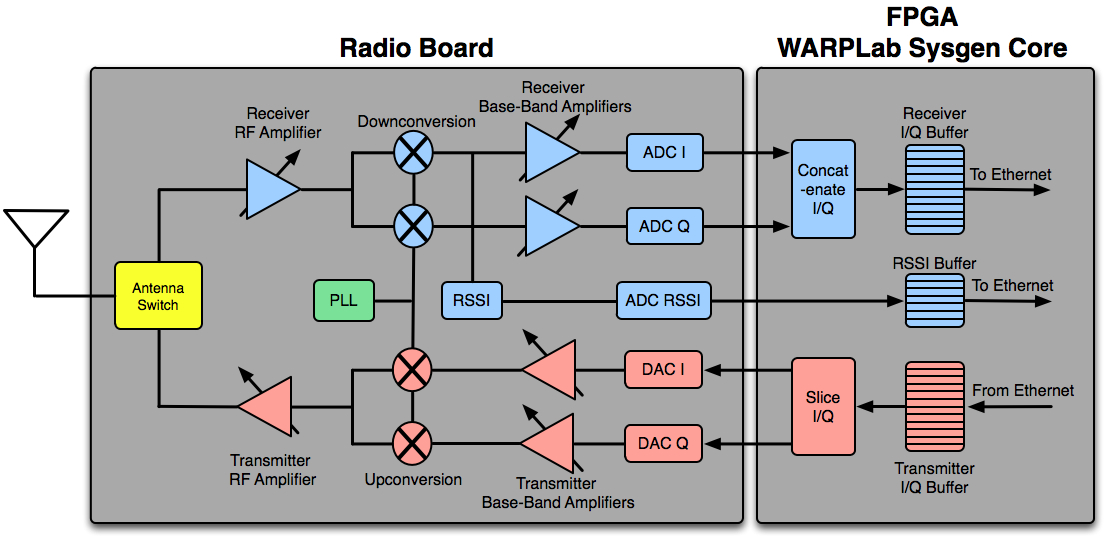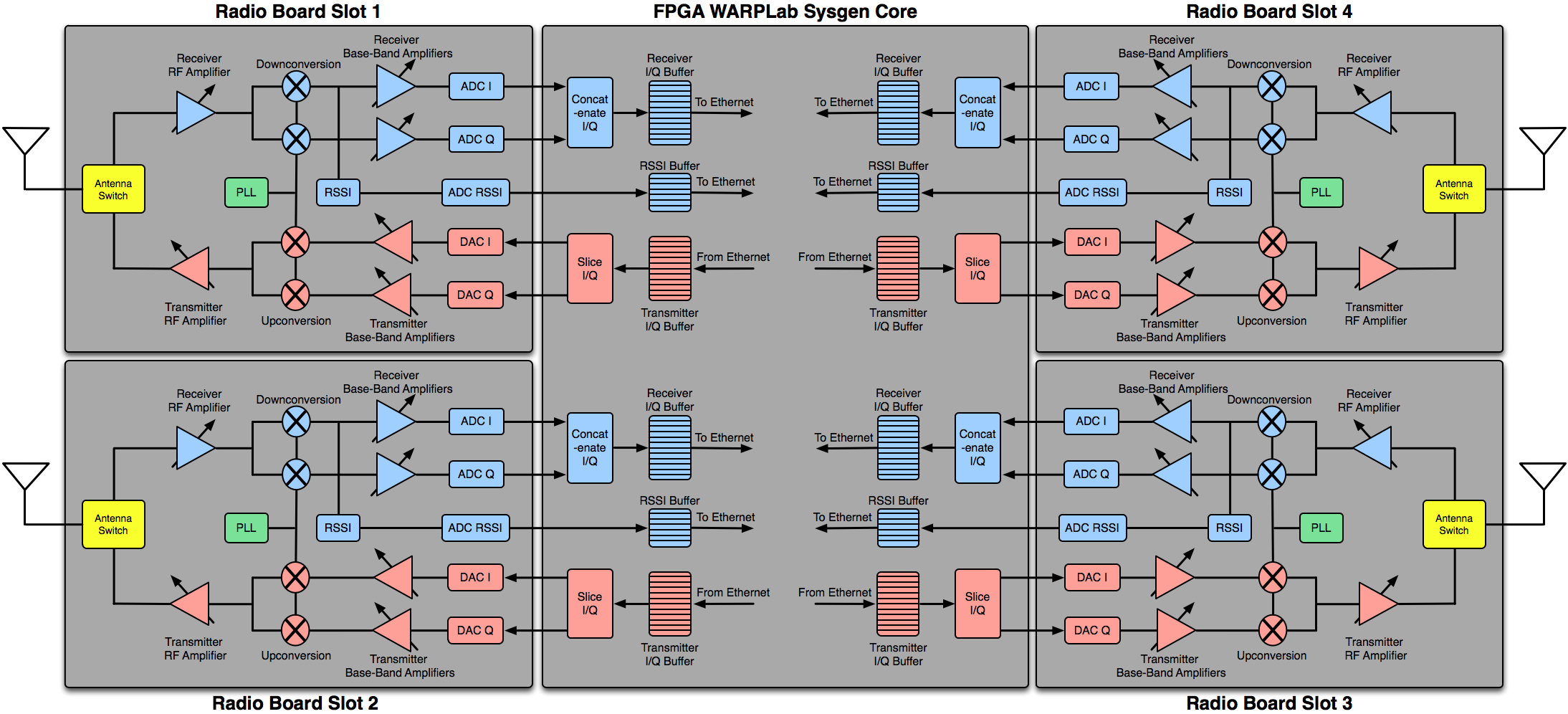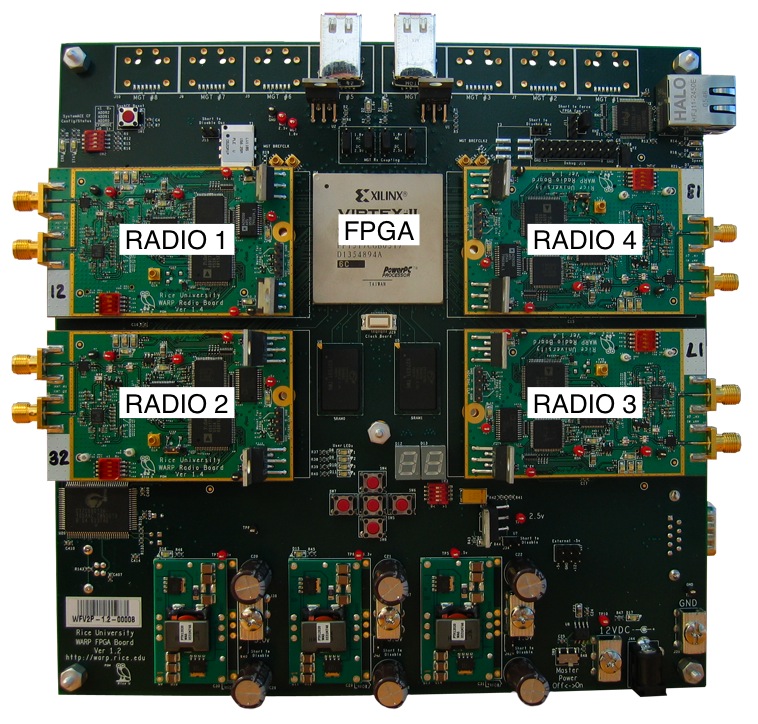WARPLab FPGA Design Architecture
Tx and Rx paths for one antenna are shown in the figure below, blocks in the Tx Path are highlighted in pink and blocks in the Rx path are highlighted in blue. The blocks are described below.
Blocks on transmitter path:
- Tx I/Q Buffers: In-Phase samples to be transmitted are stored in the Tx I Buffer and Quadrature samples to be transmitted are stored in the Tx Q Buffer.
- DAC I/Q: Digital-to-Analog Converters for In-Phase/Quadrature samples.
- Tx BB Amplifiers: Transmitter Base Band Amplifiers. There are two amplifiers, one for the I signal and one for the Q signal. These are variable Gain Amplifiers both set to the same gain value which can be input by the user from MATLAB workspace.
- Upconversion: Converts the base band signal to an RF signal. Carrier frequency depends on PLL setting.
- Tx RF Amplifiers: Transmitter RF amplifier, variable gain amplifier, gain value can be input by the user from MATLAB worksapce.
Blocks on receiver path:
- Rx RF Amplifier: Receiver RF amplifier, variable gain amplifier, gain value can be input by the user from MATLAB worksapce.
- Downconversion: Converts the RF signal to base band In-Phase/Quadrature signals. Downconversion from RF depends on PLL setting.
- Rx BB Amplifiers: Receiver Base Band Amplifiers. There are two amplifiers, one for the I signal and one for the Q signal. These are variable Gain Amplifiers both set to the same gain value which can be input by the user from MATLAB workspace.
- RSSI: Received Signal Strength Indicator. This block measures the RSSI.
- ADC I/Q: Analog-to-Digital Converters for In-Phase/Quadrature samples.
- ADC RSSI: Analog-to-Digital Converter for the measured RSSI. The RSSI data is available at 1/4th the rate of the I/Q data.
- Rx I/Q Buffers: Received In-Phase samples are stored in the Rx I Buffer and Received Quadrature samples are stored in the Rx Q Buffer.
- RSSI Buffer: RSSI data is stored in the this buffer.
PLL block: Setting of the PLL determines the carrier frequency which can be set to any of the 14 channels in the Wi-Fi 2.4 GHz band or 23 channels in the 5 GHz band. The carrier channel can be set directly from the MATLAB workspace.
NOTE: Receiver RF and BB gains can be set using Manual Gain Control (MGC) or Automatic Gain Control (AGC). In MGC mode the user picks the values for these gains and sets the gains on the boards using functions available in the WARPLab Reference M-Code. In AGC mode the board is configured so that it automatically sets receiver gains based on measured RSSI. The WARPLab framework provides examples that illustrate how to use MGC and AGC modes.
4x4 MIMO Architecture
The system generator model in the Reference Design enables all four radios. The above model is replicated for four radios and the final block diagram is shown in the following figure.
Any subset of the radios can be used - not every slot must contain a radio board. The outputs from the model describe radios connected in the following slots. For example, output of antenna 2 is connected to the radio in daughtercard slot 2.


